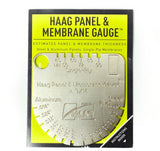Haag Panel & Membrane Gauge
Haag Panel & Membrane Gauge
- The Haag Panel & Membrane Gaugeâ„¢ estimates the thickness of steel & aluminum & single-ply membranes.
- For Steel: uncoated or coated, galvanized or Galvalume® (with or without additional coating)
- For Aluminum: uncoated and anodized panels
- For Single-ply: all single-ply membranes (excluding modified bitumen, self-adhering, and fleece-backed)
- Identifying the material in the field save hours of research.
OTHER GAUGES estimate only uncoated steel panels... The Haag Panel & Membrane Gaugeâ„¢ is different. Using published industry standards, Haag's Research/Testing Division found the measurable differences between coatings in order to bring you a unique new tool that fills a void in the industry. The Haag Panel & Membrane Gaugeâ„¢ will help you suggest replacement panels on more roofing types, with more accuracy. It may be used to estimate the thickness of both steel and aluminum panels, as well as single-ply membranes: BONUS Magnet... Sometimes it's difficult to determine if you are looking an aluminum or steel panel. The Haag Panel & Membrane Gaugeâ„¢ includes a rare earth magnet that will help you differentiate these panel types from each other. In general, if the panel is made of steel, the magnet will react. If the panel is made of aluminum, the magnet will NOT react. (Some stainless steels also are not magnetic and will not react.)
EASY To Use... Follow these easy steps to estimate:
1. Identify the type of material you are inspecting. (Use the magnet to help you determine if you are looking at aluminum or steel.)
2. Start with the widest slot. Holding the gauge loosely in one hand at a 30 degree angle to the material, drag the slot along the edge of the panel or membrane. Note that the slightest burr (rough edge on the material after cut) will misrepresent thickness. Do not force the gauge onto the material.
3. When dragging the tool, the slightest resistance constitutes refusal. The slot prior to refusal is the estimated panel thickness.
4. Take multiple measurements to qualify your results. Record all findings.
Made in the U.S.A.!



